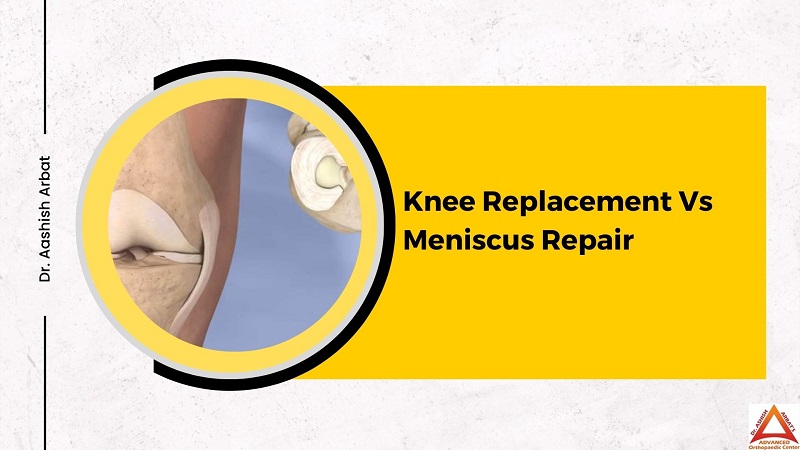
Knee Replacement Vs Meniscus Repair?? Meniscus repair or knee replacement is a common topic of debate when treating knee issues. Both procedures have benefits & drawbacks; the decision usually depends on the patient’s age, overall health, & lifestyle. This blog post will explain how a total knee replacement affects the meniscus, how to prevent arthritis after meniscus surgery, and more.
Contents
Knee Replacement Vs Meniscus Repair
Aspect | Knee Replacement | Meniscus Repair |
Definition | Surgical procedure to replace the damaged knee joint | Surgical procedure to repair the torn meniscus |
Purpose | Relieve pain & restore function in severely damaged knee joint | Preserve the meniscus & restore knee stability |
Indications | Severe arthritis, advanced joint degeneration | Torn meniscus, usually in younger patients |
Procedure | Remove damaged joint surfaces & replace with artificial components | Trim or repair the torn meniscus |
| Recovery Time | Longer recovery period | Generally shorter recovery period |
Rehabilitation | Extensive physical therapy & rehabilitation program | Physical therapy & limited weight-bearing activities |
Success Rate | High success rate in relieving pain & improving function | Success rate varies depending on tear location & severity |
Longevity of Results | Long-lasting, typically 15-20 years or more | Results can vary, may require additional treatment |
Risks & Complications | Infection, blood clots, implant failure, stiffness | Infection, blood clots, recurrent tears, limited mobility |
Ideal Candidates | Those with severe joint damage | Patients with specific meniscus tear characteristics |
| Activity Level After Surgery | Reduced impact on mobility | Faster return to activities & sports |
What Happens to the Meniscus in a Total Knee Replacement?
In a total knee replacement, the compromised components of the knee joint are surgically removed & replaced with prosthetic components. This includes the replacement of cartilage & bone on the surface of the knee joint with metal & plastic parts. This treatment also removes the meniscus, a C- shaped portion of cartilage that serves as a buffer (cushions) between the thigh bone (femur) & shin bone (tibia).
The meniscus must be removed to make a smooth surface for the new artificial joint. Notably, however, the absence of the meniscus can alter the knee’s biomechanics, causing discomfort or other complications in some patients.
On the other hand, arthroscopy vs knee replacement. Arthroscopy, often used for meniscus repair, is a less intrusive surgery than knee replacement. It involves tiny incisions, using a camera to guide the surgery, &, whenever possible, preserving the meniscus. Patients of torn meniscus over 50 may find this (meniscus repair) option preferable, as it frequently results in a speedier recovery & less post-operative pain.
How to Prevent Arthritis after Meniscus Surgery?
Arthritis is a common concern after meniscus surgery, particularly for those with no meniscus in knee. Many people fear developing knee arthritis after having their meniscus removed. This is because meniscus serves an essential function in weight distribution across the knee joint. Without it, the risk of wear & tear, which can contribute to arthritis, develops.
Therefore, to prevent arthritis after meniscus surgery, it is crucial to maintain a healthy weight to reduce stress on the knee joint. Regular low-impact exercises, such as swimming or cycling, can assist in strengthening the muscles around the knee & enhancing joint stability. In addition, physical therapy can help restore knee function & mobility.
Conclusion
Knee replacement involves replacing the entire knee joint with an artificial implant, typically for severe arthritis, whereas meniscus repair aims to repair or fix torn cartilage in specific cases. What course of action is best depends on several factors, including the patient’s age, general health, lifestyle, & the severity of the knee injury.
Consulting with Dr. Aashish Arbat, a Knee Replacement Doctor in Pune, about knee replacement vs meniscus repair is ideal option.
FAQ:
Do They Remove Meniscus with Knee Replacement?
Yes, the meniscus is removed during a total knee replacement to make space for the artificial joint components. This is necessary to ensure that the new joint fits & functions properly.
Can You Tear Your Meniscus After Total Knee Replacement?
A total knee replacement removes the meniscus, so it’s technically impossible to tear it, but patients may still have knee pain or other complications. This may be related to tissue or artificial joint abnormalities. Immediately consult Dr. Aashish Arbat, Joint Replacement Doctor in Pune, if you experience knee pain after surgery.
Can You Have Meniscus Surgery Twice on the Same Knee?
Yes, it is possible to undergo meniscus surgery on the same knee more than once. However, the decision to perform a second surgery depends on several considerations, including the patient’s overall health, knee condition, & the initial procedure’s efficacy.
Dr. Aashish Arbat – The Best Joint Replacement Doctor in Pune
Dr. Aashish Arbat is a renowned Orthopedic Doctor in Pune for his innovative joint replacement, arthroscopy, & joint conservation procedures. He specializes in Mako Robot technology, 3D Robotics, & Anatomical Joint Replacement. His dedication to his patients & his 22 years of experience in the field has made him a well-respected Orthopaedic Surgeon in Pune, Thane, & across Maharashtra.
If you’re trying to decide between knee replacement vs meniscus repair, Dr. Aashish, a Knee Replacement Doctor in Pune, is an excellent choice for expert guidance.
Reference
- https://my.clevelandclinic.org/health/treatments/21508-meniscus-surgery#:~:text=Meniscus%20surgery%20is%20a%20common,rehabilitation%20take%20a%20few%20weeks.
- https://my.clevelandclinic.org/health/treatments/21508-meniscus-surgery
- https://iorthomd.com/arthroscopic-knee-replacement/
- https://www.ewmotiontherapy.com/blog/meniscus-repair-vs-total-knee-arthroplasty

